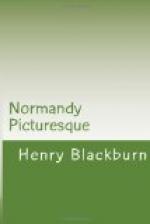The church of St. Jacques with its fine stained-glass, the interior of which is much plainer than St. Pierre, will not detain us long; it is rather to such streets as the celebrated ‘Rue aux Fevres’ that we are attracted by the decoration of the houses, and their curious construction. There is one house in this street, the entire front of which is covered with grotesquely carved figures, intricate patterns, and graceful pillars. The exterior woodwork is blackened with age, and the whole building threatens to fall upon its present tenant—the keeper of a cafe. The beams which support the roof inside are also richly decorated.
To give the reader any idea of the variety of the wooden houses at Lisieux would require a series of drawings or photographs: we can do little more in these pages than point out these charming corners of the world where something is still left to us of the work of the middle ages.
The general character of the houses is better than at Pont Audemer, and the style is altogether more varied. Stone as well as wood is used in their construction, and the rooms are more commodious and more elaborately decorated. But the exterior carving and the curious signs engraved on the time-stained wood, are the most distinctive features, and give the streets their picturesque character. Here we may notice, in odd corners, names and legends carved in wood on the panels, harmonizing curiously with the decoration; just as the names of the owners (in German characters) are carved on Swiss chalets; and the words ’God is great,’ and the like, form appropriate ornaments (in Arabic) over the door of a mosque.[12] And upon heraldic shields, on old oak panels, and amidst groups of clustering leaves, we may sometimes trace the names of the founders (often the architects) of the houses in which several generations lived and died.
[Illustration]
The strange familiarity of some of these crests and devices (lions, tigers, dragons, griffins, and other emblems of ferocity), the English character of many of the names, and the Latin mottos, identical with some in common use in England, may give us a confused and not very dignified idea respecting their almost universal use by the middle classes in England. M. Taine, a well-known french writer, remarks that ’c’est loin du monde que nous pouvons jugez sainement des illusions dont nous environt,’ and perhaps it is from Lisieux that we may best see ourselves, wearing ‘coats of arms.’
It is considered by many an unmeaning and unjust phrase to call the nineteenth century ‘an age of shams,’ but it seems appropriate enough when we read in newspapers daily, of ‘arms found’ and ‘crests designed;’ and when we consider the extent of the practice of assuming them, or rather we should say, of having them ‘found,’ we cannot feel very proud of the fashion. Without entering into a genealogical discussion, we have plenty of evidence that the Normans held their lands and titles




